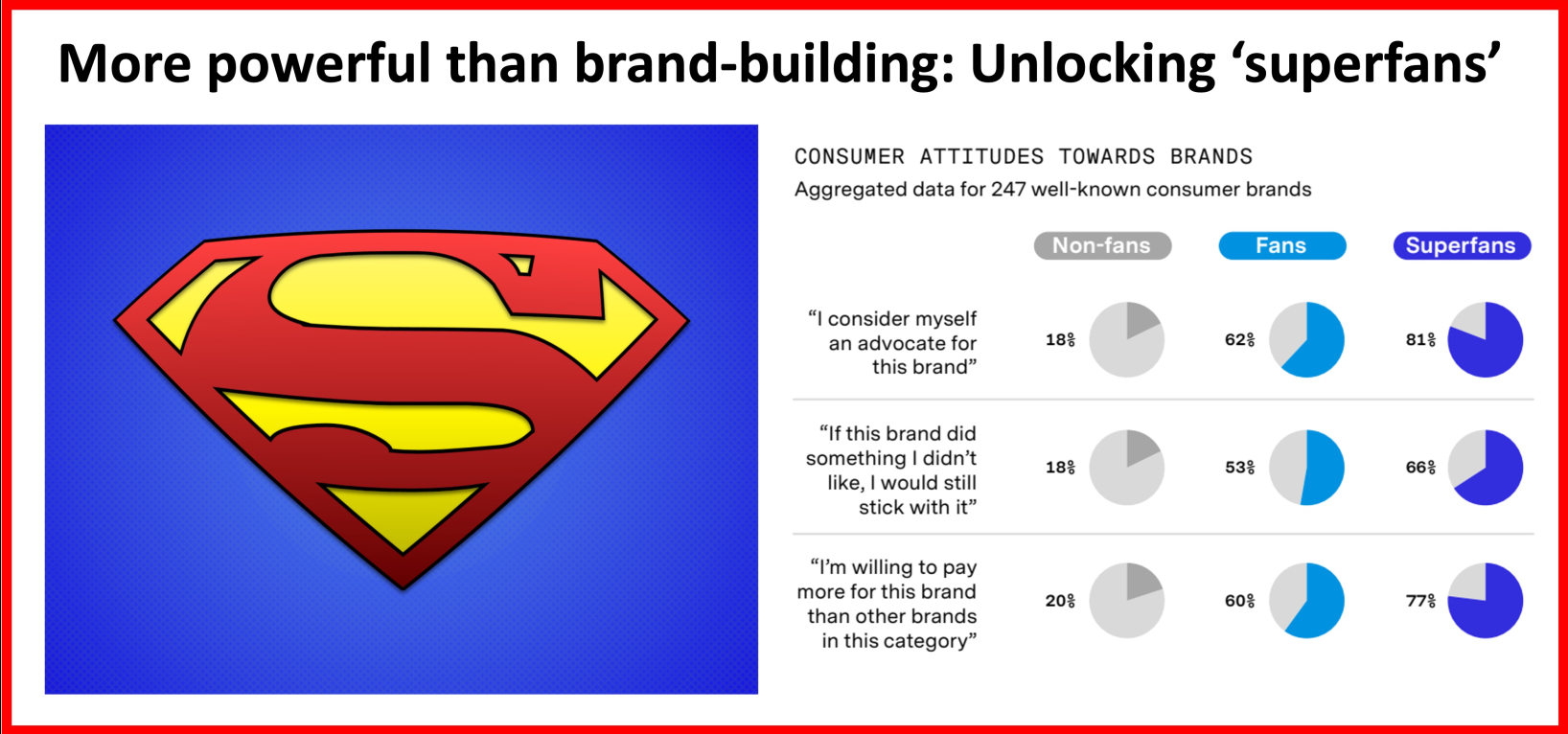The Stagwell News Network launches in partnership with eight premier publishers
New study of 7,000+ U.S. adults finds rising news consumption and greater ad lift among the most engaged news audiences, reinforcing the value of advertising in news.
Research to be built upon throughout Future of News programming at Cannes Lions
NEW YORK, June 13, 2025 /PRNewswire/ — Stagwell (NASDAQ: STGW), the challenger network built to transform marketing, today announced the launch of the Stagwell News Network, a private marketplace (PMP) associated with its Future of News initiative. As Stagwell continues to drive greater investment into news by bringing together leaders from marketing and news media around data and forward-looking discussions, the News Network will give Stagwell clients unique access to publishers – strengthening Stagwell’s ability to deliver premium news inventory and performance-driven solutions for clients.
The News Network’s launch partners are Newsweek, Nexstar, NPR, Ozone, RealClear Politics, The Associated Press, The Washington Post, and TIME.
This announcement coincides with Stagwell and the Future of News initiative’s expanded presence at the Cannes Lions International Festival of Creativity 2025. Leading up to the festival, Stagwell today unveiled new ad performance-based research, conducted by Stagwell’s research consultancy HarrisX among 7,126 U.S. adults, that reveals a clear loss in campaign reach and effectiveness when foregoing news advertising.
Key findings from the study include:
News Consumers are High-Impact Audiences
- News Junkies — roughly 80.4 million U.S. adults who follow the news ‘very closely’ — view brands more positively than less engaged audiences across seven key brand and reputation metrics, including purchase intent, favorability, likelihood to recommend, and trustworthiness.
- Among News Junkies, a key target group for advertisers, the average purchase intent for 20 brand ads tested across technology, travel/hospitality, CPG, financial services, and automotive, was 66%— compared to 50% among the rest of the general population.
- 13.8% of U.S. adults, or approximately 36.8 million individuals, are Exclusive News Junkies, defined as those who follow the news ‘very closely’ but do not closely follow sports or entertainment.
- Exclusive New Junkies show greater post-ad exposure lift than the rest of the general population, making it clear they are an underserved advertising audience who responds to ads.
News Engagement is Growing
- Since 2024, Exclusive News Junkies have grown in population size by approximately 7.2 million U.S. adults, now making up 13.8% of the general population compared to 11.1% a year ago.
- Nearly 60% of News Junkies and Exclusive News Junkies now follow the news more closely than they did a year ago.
- News Junkies and Exclusive News Junkies are now paying particularly more attention to political, international, and economic news than a year ago.
“This research shows that campaigns including news in the media mix consistently outperform those that forego news, and as the population of Exclusive News Junkies expands, brands that ignore news advertising are missing the opportunity to drive real results,” said Stagwell Chairman and CEO Mark Penn.
Since beginning news-focused testing in the second half of 2023, Stagwell has seen 2024 campaigns deliver three times the average return on ad spend (ROAS). According to Stagwell agency Assembly’s Media Mix Model, news delivers commercial impact, with three times higher ROAS than other paid media channels, and 136% transaction growth for a leading global logistics business.
“We’re turning insight into action–from debuting new research for Cannes that proves the power of news audiences, to launching the Stagwell News Network with eight leading publishers, and hosting the first-ever NewsFronts event this October. We’re doubling down on the power of news as a critical platform for marketers and advertisers,” added Alexis Williams, Chief Corporate Affairs Officer at Stagwell.
Join the Future of News team for programming throughout Cannes Lions:
- RTL AdAlliance Beach | The Business of News | Monday, June 16, 10:30 AM CEST
- WSJ’s Journal House | Hard Truths, Real Results: How News Unlocks Advertising ROI | | Monday, June 16, 4:15 PM CEST
- ADWEEK House | The Business of News | Tuesday, June 17, 1:30PM CEST
- SPORT BEACH | Future of News Breakfast Roundtable | Wednesday, June 18, 9:00 AM CEST
- SPORT BEACH | Future of News: Why News Junkies are the Real MVPs | Wednesday, June 18, 1:00 PM CEST
To learn more about Stagwell’s Future of News Initiative, please reach out to futureofnews@stagwellglobal.com. To request a copy of the latest research, please visit https://www.stagwellglobal.com/future-of-news/.
About Stagwell
Stagwell is the challenger holding company built to transform marketing. We deliver scaled creative performance for the world’s most ambitious brands, connecting culture-moving creativity with leading-edge technology to harmonize the art and science of marketing. Led by entrepreneurs, our specialists in 45+ countries are unified under a single purpose: to drive effectiveness and improve business results for our clients. Join us at www.stagwellglobal.com.
Contact
Madison Wick
PR@stagwellglobal.com

Related
Articles
In the News, Press Releases, Thought Leadership
Jun 10, 2025
Stagwell (STGW) Chairman and CEO Mark Penn to Discuss the Irreplaceable Power of Human Creativity on the Main Stage of Cannes Lions

Events, In the News, Press Releases, Talent & Awards
Jun 05, 2025
Code and Theory Named ANA B2B Agency of the Year After Transforming the World’s Leading Brands

In the News, Press Releases, Talent & Awards
May 19, 2025
Stagwell (STGW) Appoints Connie Chan as Chief Growth Officer for Asia Pacific

Newsletter
Sign Up
Originally Released On
Contact:
John Gerzema
jgerzema@harrispoll.com
Drew Higham
Drew.Higham@harrispoll.com
Jacklyn Cooney
Jacklyn.Cooney@harrispoll.com
Many companies fail to fulfill consumer needs as inflation has shifted America’s focus and priorities toward seeking value and spending more carefully.
This, according The Axios-Harris Poll 100 Rankings on Corporate Reputation released this morning, is why Trader Joe’s ranked first – followed by other value-prioritizing brands like Toyota and Arizona Beverage Company – among the top 10 most reputable companies in the country this year.
NEW YORK, May 20, 2025 /PRNewswire/ — Americans, fatigued by a third year of inflation, high interest rates, and tariff uncertainty, gave nearly half of all businesses poorer marks in the 27th annual study of corporate reputation conducted by Harris’ (RQ) Reputation Quotient Survey. Among the top 100 index of companies, more declined (46%) than improved (37%), as consumers criticized businesses for passing along higher costs, delivering poorer perceived quality for their stretched dollars, and even capitalizing on tariffs to pad profit margins.
Of note:
- 77% of Americans say companies often sell lower-quality products and services while charging higher prices.
- 70% believe companies are taking further advantage of inflation to increase their profit margins.
- 60% feel companies will use tariffs as an opportunity to raise prices more than needed to boost profits.
This comes as Americans are split over whether the economy is improving and whom to blame for their personal financial situation. Among those who feel stuck (39%) and falling behind (28%) – a quarter (26%) fault business for their predicament. Among those with a declining opinion of business, their number one reason cited was “companies not doing enough to keep prices fair from inflation”. And over half of all Americans said they had recently stopped doing business with a company due to unreasonably high prices (63%) and quality falling below expectations (54%).
“As opposed to COVID, when corporate reputations surged with breakthrough vaccines and reliable package delivery, businesses haven’t answered this moment,” says John Gerzema, CEO of The Harris Poll. “Americans don’t see business with a solve for inflation. They want an ally.”
Other key findings:
- Inflation fighters come out on top: Prioritizing the consumer paid off for some companies with Trader Joe’s experience the sixth largest increase in score (+3.5) to take the top spot. New-comer Arizona Beverage Co. (99 cent price policy) emerges at #7.
- Perceived quality is falling: Consumers are twice as likely to say the quality of goods and services is falling behind their current prices than exceeding them (48% v. 22%). Especially as two-thirds (69%) report a noticeable decline in the quality of their everyday items.
- AI is still more hype than utility for most: More Americans today than last year don’t find it important for companies to integrate AI into their products and services (47%, +5%-pts from May 2024), saying companies often overestimate their interest in AI-infused products (71%). With over two in five (43%) even against companies marketing that they use AI.
- Businesses should go back to the basics: American consumers point to quality as the most important consideration when considering company reputations today, followed by customer service, employee treatment and prices. As over three-quarters (79%) say brands with the best reputation are the ones prioritizing consumer wallets.
The Axios Harris Poll 100 is based on a survey of nearly 25,000 Americans in a nationally representative sample conducted January through March. The two-step process starts fresh each year by surveying the public’s top-of-mind awareness of companies that either excel or falter. These 100 “most visible companies” are then ranked by a second group of Americans across the seven key dimensions of reputation to arrive at the ranking. If a company is not on the list, it did not reach a critical level of visibility to be measured.
For information on all companies and their ranking on the 2025 Axios-Harris Poll 100, or to purchase an in-depth analysis of a company’s reputation, click here.
About The Harris Poll
The Harris Poll is one of the longest-running surveys in the U.S., tracking public opinion, motivations and social sentiment since 1963. It is now part of Harris Insights & Analytics, a global consulting and market research firm that delivers social intelligence for transformational times. We work with clients in three primary areas: building 21st century corporate reputation, crafting brand strategy and performance tracking, and earning organic media through public relations research. Our mission is to provide insights and advisory to help leaders make the best decisions possible. Learn more by visiting www.harrispoll.com and follow Harris Poll on Twitter and LinkedIn.
About Axios
Axios is a digital media company launched in 2017. Axios – which means “worthy” in Greek – helps you become smarter, faster with news and information across politics, tech, business, media, science and the world. Subscribe to our newsletters at axios.com/newsletters and download our mobile app at axios.com/app.
About Stagwell
Stagwell is the challenger holding company built to transform marketing. We deliver scaled creative performance for the world’s most ambitious brands, connecting culture-moving creativity with leading-edge technology to harmonize the art and science of marketing. Led by entrepreneurs, our specialists in 45+ countries are unified under a single purpose: to drive effectiveness and improve business results for our clients. Join us at www.stagwellglobal.com.
Contact
John Gerzema
jgerzema@harrispoll.com
Drew Higham
Drew.Higham@harrispoll.com
Jacklyn Cooney
Jacklyn.Cooney@harrispoll.com
51% OF VOTERS SAY THE ECONOMY IS STRONG TODAY, UP 5 POINTS FROM APRIL
VOTERS VIEW TRUMP’S IMMIGRATION POLICIES AS HIS BIGGEST ACHIEVEMENT AND TARIFFS AS BIGGEST FAILURE IN FIRST 100 DAYS AS PRESIDENT
MAJORITY OF VOTERS FAVOR TRUMP’S TRIP TO SAUDI ARABIA
NEW YORK and CAMBRIDGE, Mass., May 19, 2025 /PRNewswire/ — Stagwell (NASDAQ: STGW) today released the results of the May Harvard CAPS / Harris poll, a monthly collaboration between the Center for American Political Studies at Harvard (CAPS) and the Harris Poll and HarrisX.
President Donald Trump’s approval rating sits at 47% (-1 pts., Apr. 2025), with 87% of Republican voters approving and 83% of Democrats and 50% of Independents disapproving. Approval is higher among male than female voters, with a 17-point gender gap, and among white, rural, and 25-64 y.o. voters. Trump received the strongest approval on immigration (51%) and returning America to its values (51%) and the weakest approval (42%) on tariffs and trade policy and handling inflation (43%). This month’s poll also covered public opinion on the economy, immigration, tariffs, government efficiency, Middle East, and Ukraine. Download key results here.
“The majority of Trump’s policies continue to see strong support especially on immigration and government efficiency, even though there is concern Trump has exceeded guardrails with executive orders and tariffs,” said Mark Penn, Co-Director of the Harvard CAPS / Harris poll and Stagwell Chairman and CEO. “If he is able to successfully lower the price of prescription drugs and hold down the fort on inflation, he will be able to unlock 10% more of voters in his approval rating.”
VOTERS MORE OPTIMISTIC ON THE DIRECTION OF THE COUNTRY AND THEIR PERSONAL FINANCIAL SITUATION
- 42% of voters say the country is on the right track (+3 pts., Apr. 2025; +16, Nov. 2024).
- 34% of voters say their personal financial situation is improving (+2), while 39% say their personal financial situation is getting worse (-6), the lowest percentage since October 2021. Republican, male, Black, and 18-44 y.o. voters are more likely than not to say it is improving.
- The Republican Party’s approval rating reached 52%, the highest approval rating for the party since March 2023.
- The Democratic Party’s approval rating is at 42%, with more urban voters approving than disapproving (+4 pts. net approve), and more suburban (-22) and rural (-32) voters disapproving.
- Among Trump’s cabinet members, voters have a more favorable view of Robert F. Kennedy Jr. (+9 net favorable), Marco Rubio (+4), and Tulsi Gabbard (+4), and a more unfavorable view of Elon Musk (-8) and Pete Hegseth (-4). Voters are split on Trump and Vice President J.D. Vance.
- Inflation and the economy remain the top issues for voters across political parties. 40% of voters say inflation is the most important issue to them personally.
MOST OF TRUMP POLICIES CONTINUE TO RECEIVE MAJORITY SUPPORT, INCLUDING STRONGEST SUPPORT FOR LOWERING DRUG PRICES
- Voters continue to support Trump’s immigration and government efficiency policies, but oppose caps to Medicaid and tariffs on China, Mexico, and Canada. 70% of voters support raising the top income tax rate.
- 84% of voters support lowering prescription drug prices for Medicare recipients and low-income patients (Democrats: 79%; Republicans: 89%; Independents: 82%).
- 59% of voters hold Trump responsible for the state of the economy today.
- Voters are split on whether Trump is making good or bad tariff deals on behalf of the country, but 60% believe he will reach a trade deal with China.
- 58% of voters say Trump will not solve the Ukraine war, and 59% say the same about the Israel-Hamas war.
- 40% of voters, a plurality, say making the 2017 Tax Cuts permanent will not make a difference in U.S. government debt, but more voters saying it will increase (35%) rather than decrease (25%) debt.
THOUGH VOTERS REMAIN SPLIT ON TARIFFS, VOTERS ARE MORE OPTIMISTIC ABOUT THE ECONOMY AS MARKET FEARS COOL DOWN
- 57% of voters do not believe we are in a recession.
- 50% of voters have confidence Trump’s policies will lead to stronger economic growth, though 54% of voters believe Trump is losing the battle against inflation.
- Voters are split 50-50 on whether Trump’s policies are making the U.S. economy stronger, leading to more jobs, and bringing more investment, with Independents more pessimistic on the impact of his policies.
- 57% of voters believe Trump’s tariff policies are harming the economy (Democrats: 87%; Republicans: 22%; Independents: 64%). 49% of voters, a plurality, say his administration went too far with tariffs.
- 57% of voters believe the Trump administration has some wins to show for its tariff policies, while 55% say they will play out successfully with time.
- 60% of voters say the U.S. has been taken advantage of by other countries when it comes to trade.
- Overall, 46% of voters support the administration’s tariff program (+1, Apr. 2025) and 47% oppose it (0), with a plurality of Independents (47%) opposing.
MAJORITY OF VOTERS SUPPORT DEPORTING ILLEGAL CRIMINALS BUT WANT DEPORTATIONS TO FOLLOW DUE PROCESS
- 63% of voters support the administration’s actions to close the Southern border.
- 75% of voters support deporting illegal criminals, though 53% of voters believe the administration is unfairly deporting people who are not really criminals.
- 57% of voters support Democratic efforts to stop deportations and ensure hearings and trials take place before deportation, and 59% believe Democrats are defending human rights in doing so. But voters are split on whether illegal immigrations should be deported promptly (51%) or await trial (49%).
- 63% favor sending convicted and imprisoned illegal immigrants to serve their sentence in another country.
- 52% of voters say the Trump administration does not have a case to suspend habeas corpus rights.
VOTERS WANT CUTS IN GOVERNMENT SPENDING BUT ARE SPLIT ON THE SUCCESS OF DOGE
- Voters continue to overwhelmingly support moving to balance the budget in the next few years (80%) and reducing government expenditures (78%), with at least a two-thirds majority across parties.
- 62% of voters believe the current level of U.S. federal government debt is unsustainable (Democrats: 70%; Republicans: 46%; Independents: 72%).
- Voters are split 50-50 on whether DOGE has been successful in meeting its stated mission so far, with 55% of voters saying it has been effective at cutting spending.
- 67% of voters support the goal of cutting $1 trillion in government expenditures, but 59% of voters do not believe Elon Musk and DOGE will be able to hit the goal by the end of the year (+2).
- Voters are unsure of how much DOGE has saved the U.S. government to date, with 51% of voters estimating DOGE has saved under $100 billion – $60 billion less than DOGE‘s alleged savings.
- 54% of voters say Musk and DOGE have gone about making cuts to government expenses in the wrong way so far.
VOTERS FAVOR RELATIONS WITH SAUDI ARABIA AND CONTINUE TO SUPPORT ISRAEL BUT HAVE CONCERNS OVER JET FROM QATAR
- 59% of voters support Trump’s efforts to have strong relations with Saudi Arabia (Democrats: 34%; Republicans: 84%; Independents: 56%); and 52% say Saudi Arabia can be a trusted partner.
- 54% of voters support Trump’s handling of the Israel-Hamas conflict so far (+3, Apr. 2025).
- 77% of voters and a majority across age groups support Israel over Hamas.
- 62% of voters support Trump opening nuclear weapons negotiations with Iran directly (+2), and 39% say such negotiations will lead to a good deal (+7).
- 62% of voters say Trump’s acceptance of the luxury Boeing 747 from Qatar raises ethical concerns about corruption (Democrats: 85%; Republicans: 40%; Independents: 62%).
- 59% of voters oppose taking sanctions off the new Syrian government when told the new government is led by a former guerilla accused of terrorism.
SUPPORT FOR UKRAINE REMAINS HIGH AS VOTERS WANT TRUMP TO BE TOUGHER ON RUSSIA
- 66% of voters think Russian President Vladimir Putin is playing games and stalling the U.S. and the West, while 62% of voters believe Ukraine’s President Volodymyr Zelenskyy genuinely wants to end the war.
- 62% of voters believe the Trump administration should continue to provide weaponry to Ukraine and impose sanctions on Russia (Democrats: 71%; Republicans: 59%; Independents: 56%).
- 64% of voters believe Ukraine should receive direct security guarantees from the U.S. were it to make concessions to end the war with Russia, including a majority across parties.
- 59% of voters believe Trump has not been tough enough when dealing with Putin and the Russians.
- Voters are split 50-50 on whether they are satisfied with Trump’s negotiations between Ukraine and Russia, with 79% of Republicans satisfied and 76% of Democrats and 55% of Independents not satisfied.
The May Harvard CAPS / Harris poll survey was conducted online within the United States on May 14-15, 2025, among 1,903 registered voters by The Harris Poll and HarrisX. Follow the Harvard CAPS / Harris poll podcast at https://www.markpennpolls.com/ or on iHeart Radio, Apple Podcasts, Spotify, and other podcast platforms.
About The Harris Poll & HarrisX
The Harris Poll is a global consulting and market research firm that strives to reveal the authentic values of modern society to inspire leaders to create a better tomorrow. It works with clients in three primary areas: building twenty-first-century corporate reputation, crafting brand strategy and performance tracking, and earning organic media through public relations research. One of the longest-running surveys in the U.S., The Harris Poll has tracked public opinion, motivations, and social sentiment since 1963, and is now part of Stagwell, the challenger holding company built to transform marketing.
HarrisX is a technology-driven market research and data analytics company that conducts multi-method research in the U.S. and over 40 countries around the world on behalf of Fortune 100 companies, public policy institutions, global leaders, NGOs and philanthropic organizations. HarrisX was the most accurate pollster of the 2020 U.S. presidential election.
About the Harvard Center for American Political Studies
The Center for American Political Studies (CAPS) is committed to and fosters the interdisciplinary study of U.S. politics. Governed by a group of political scientists, sociologists, historians, and economists within the Faculty of Arts and Sciences at Harvard University, CAPS drives discussion, research, public outreach, and pedagogy about all aspects of U.S. politics. CAPS encourages cutting-edge research using a variety of methodologies, including historical analysis, social surveys, and formal mathematical modeling, and it often cooperates with other Harvard centers to support research training and encourage cross-national research about the United States in comparative and global contexts. More information at https://caps.gov.harvard.edu/.
Contact:
Carrie Hsu
pr@stagwellglobal.com
Related
Articles
In the News, Press Releases
Jun 13, 2025
Stagwell (STGW) Unveils Official News Network as an Extension of its Future of News Initiative, Allowing Clients Direct Access to Leading News Publishers
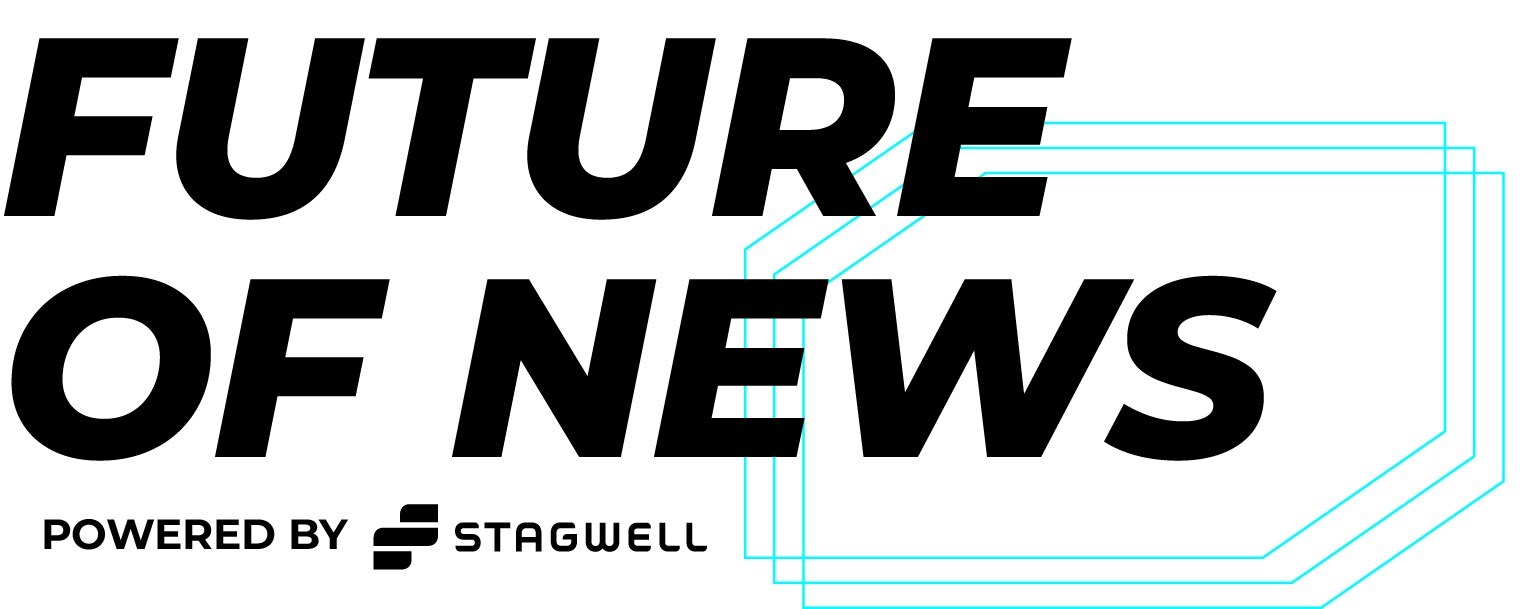
Artificial Intelligence, In the News, Marketing Frontiers, Press Releases, Stagwell Marketing Cloud, Tech
Jun 12, 2025
PRophet, a Stagwell (STGW) Company, Completes Integration of UNICEPTA, Launches Unified Brand and Enhanced Media Intelligence Offering

In the News, Marketing Frontiers, Press Releases, Stagwell Marketing Cloud, Tech
Jun 11, 2025
The Marketing Cloud Launches Cutting-Edge Platform to Simplify Marketing Workflows
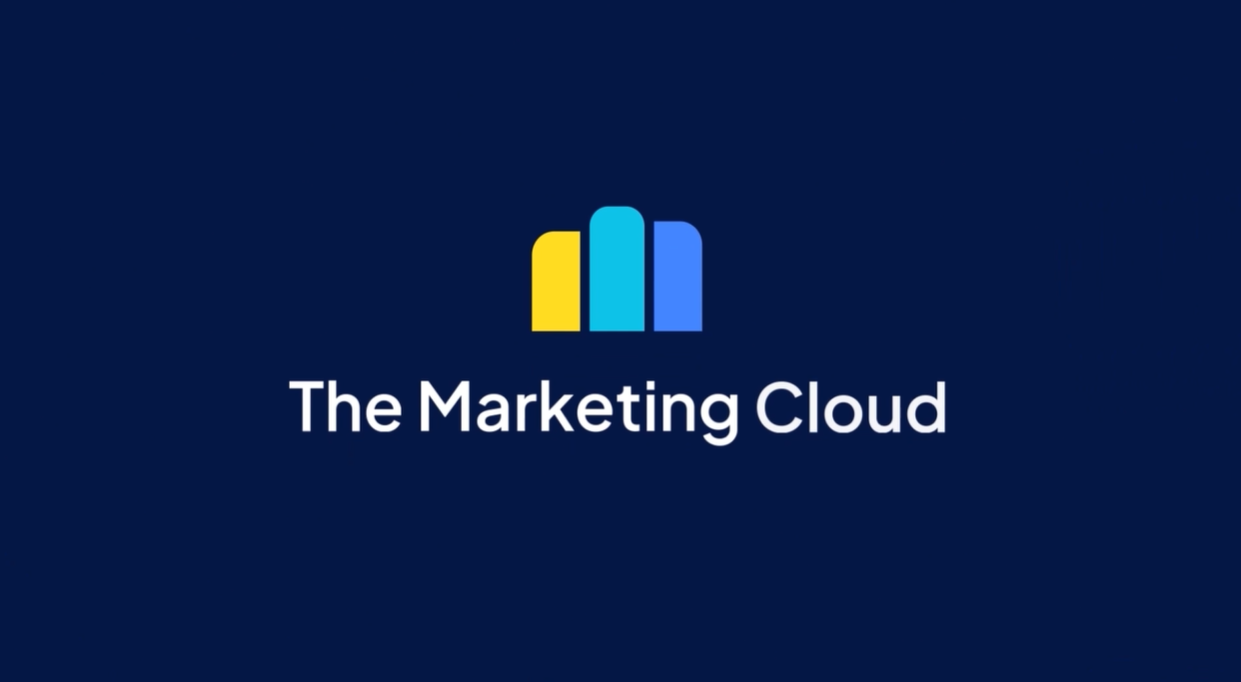
Newsletter
Sign Up
DEMOCRATIC PARTY APPROVAL REMAINS UNDERWATER WITH 71% OF VOTERS SAYING IT NEEDS NEW MODERATE LEADERS
79% OF VOTERS WANT THE GOVERNMENT TO BALANCE THE BUDGET BY REDUCING EXPENDITURES BUT NEARLY HALF ARE UNSURE BY HOW MUCH
ELON MUSK FAVORABILITY DROPS FROM NEUTRAL TO 10-POINT NET UNFAVORABLE
NEW YORK and CAMBRIDGE, Mass., March 31, 2025 /PRNewswire/ — Stagwell (NASDAQ: STGW) today released the results of the March Harvard CAPS / Harris poll, a monthly collaboration between the Center for American Political Studies at Harvard (CAPS) and the Harris Poll and HarrisX.
In his second month in office, President Donald Trump’s approval rating is at 49%, 3 points lower than February 2025, with majority approval among Republican, male, 25-64 y.o., white, and rural voters. Most of his policies continue to see strong support, with the deportation of illegal immigrants who have committed crimes (80%), closing the border (74%), and eliminating fraud and waste in government expenditures (72%) most popular. Tariffs on China, Mexico, and Canada (50%) and renaming the Gulf of Mexico (39%) are his least popular policies. This month’s poll also covered public opinion on immigration, separation of powers, the budget, tariffs, and U.S. foreign policy in the Middle East and Ukraine. Download key results here.
“There’s still strong support for most of Trump’s policies while Democratic Party approval continues to nosedive,” said Mark Penn, Co-Director of the Harvard CAPS / Harris poll and Stagwell Chairman and CEO. “Opinions are still in formation as people are unsure how tariffs will affect the economy, but voters generally believe he is doing a better job than Biden.”
GENERAL MOOD ABOUT THE DIRECTION OF THE COUNTRY REMAINS MORE OPTIMISTIC THAN BIDEN TERM
- 38% of voters say the U.S. economy is on the right track, consistent with last month and up 10 points from January 2025.
- 33% of voters say their personal financial situation is improving (+2 pts. from February 2025), though more Democrats, Independents, women, 18-24 year-olds, Hispanics, and rural voters feel their situation worsening than improving.
- Inflation, the economy, and immigration remain the top three issues for voters, with 43% of voters saying inflation is the most important issue to them personally.
TRUMP APPROVAL RATINGS SEE SLIGHT DROP FROM LAST MONTH; KEY REPUBLICANS SEE MIXED FAVORABILITY
- 42% of voters say Trump is doing worse than expected (+7 pts, Feb. 2025), but 54% say Trump is doing a better job than Joe Biden as President (Democrats: 19%; Republicans: 89%; Independents: 50%).
- Trump’s approval ratings on key issues have dropped across the board, with voters most approving of his performance on immigration (53%), reducing the cost of the government (49%), and returning America to its values (49%).
- Voters have a more favorable view of Robert F. Kennedy Jr. (+7 more favorable than unfavorable), and a more unfavorable view of Elon Musk (-10) and Pete Hegseth (-5). Voters are split on Marco Rubio and Trump.
DEMOCRATIC PARTY APPROVAL RATINGS REMAIN AT RECORD-LOW; MOST SAY THE PARTY NEEDS NEW MODERATE LEADERS
- 37% of voters approve of the Democratic Party (the lowest since at least March 2018 aside from February 2025 (36%)), with the majority of voter groups other than Democrats and Black voters disapproving. 34% of Democrats and 43% of Black voters disapprove.
- 71% of voters say the Democratic Party needs new moderate figures to lead the party into the 2026 midterms and 2028 election, including 57% of Democrat voters.
- 55% of voters support moderate Democrats who are willing to compromise with Trump on issues (Democrats: 27%; Republicans: 78%; Independents: 59%) over Democrats who want to fight harder against the administration.
- 57% of voters approve of Senate Minority Leader Chuck Schumer and other Democrats supporting the GOP spending bill that funds the government until September 30 rather than holding the line on Democratic demands risking government shutdown (Democrats: 46%; Republicans: 71%; Independents: 51%).
MIXED VIEWS ON CONSTITUTIONAL RIGHTS OF ILLEGAL, STUDENT VISA, AND GREEN CARD MIGRANTS
- 58% of voters support birthright U.S. citizenship for the children of illegal immigrants (Democrats: 80%; Republicans: 40%; Independents: 56%), with 64% and a majority across parties believing it to be a constitutional requirement.
- 62% of voters say illegal immigrants should not have the same First Amendment rights as U.S. citizens and should be subject to deportation if they support causes counter to U.S. foreign policy.
- But 53% of voters say legal migrants on student visas have such rights, and 63% of voters say the same for green card holders (Democrats: 75%; Republicans: 40%; Independents: 64%).
- 69% of voters believe the federal government should have the authority to revoke green cards and deport individuals if it can prove active support for U.S.-designated terrorist organizations like Hamas (Democrats: 55%; Republican: 86%; Independents: 64%).
MAJORITY OF VOTERS BELIEVE POWER TO HALT A NATIONWIDE PROGRAM SHOULD BE RESERVED FOR A PANEL OF MULTIPLE JUDGES
- 56% of voters say the administration is exceeding its authority and getting hit with fair injunctions restraining its powers (Democrats: 73%; Republicans: 40%; Independents: 56%).
- 52% of voters say the president should be able to deport suspected members of Venezuelan criminal gangs without a court trial.
- 50% of voters believe a federal judge has the authority to turn around military planes under suspicion of wrongful immigration procedures.
- 52% of voters say federal judges are in general acting appropriately within their authority (Democrats: 66%; Republicans: 41%; Independents: 49%).
- But 69% of voters and a majority across parties say the power to halt a nationwide program should be reserved for a panel of judges rather than a single federal judge.
AMERICANS WANT TO BALANCE THE BUDGET AND CUT DOWN GOVERNMENT EXPENDITURES BUT DON’T KNOW HOW MUCH TO CUT AND WHETHER MUSK AND DOGE ARE HELPING
- The majority of voters continue to say the current level of U.S. federal government debt is unsustainable (68%), the government should move to balance the budget in the next few years (83%), and it should do so by reducing government expenditures rather than increasing taxes (79%). But the plurality of voters (47%) are unsure how much expenditure to cut.
- 63% of voters perceive government expenditures are filled with waste, fraud, and inefficiency.
- 68% of voters support the goal of cutting $1 trillion of government expenditures, but only 42% believe Musk and DOGE will be able to hit the goal by the end of the year.
- 56% of voters say DOGE and Musk are helping make major cuts in government expenditures (Democrats: 33%; Republicans: 83%; Independents: 50%).
VOTERS BELIEVE U.S. SHOULD RESET TRADE AND TARIFF POLICIES WITH CHINA, MEXICO, AND CANADA
- Voters are split on whether Trump’s tariffs will end on better terms for the U.S. (51%) or if they will be counterproductive and worsen the economy (49%).
- 59% of voters say the U.S. should reset trade and tariff policies with China, Mexico, and Canada (Democrats: 45%; Republicans: 72%; Independents: 60%).
- The majority of voters believe China (67%) and Mexico (53%) are taking advantage of the U.S. in trade and tariff policies, while 54% believe Canada is acting fairly.
U.S. ACTIONS AGAINST IRAN AND HOUTHI TERRORISTS RECEIVE SUPPORT BUT MOST SAY IT WAS WRONG TO HOLD DISCUSSION ON SIGNAL APP
- Support for Israel over Hamas in the conflict (77%) remains unchanged. 54% of voters support Trump’s handling of the conflict (+21 points, Biden in January 2025).
- 72% of voters support destroying Iran’s nuclear weapons facilities, and 59% of voters say the U.S. should support Israel in airstrikes to do so.
- 71% of voters support the administration’s air strikes against Houthi terrorists who were firing missiles at U.S. warships and blocking shipping at the Suez Canal (Democrats: 58%; Republicans: 86%; Independents: 68%), with 60% of voters agreeing the U.S. was right to engage rather than leave it to Europe.
- 60% of voters, however, say it was wrong to hold the discussion on Houthi strikes over the Signal app. 56% believe the journalist was added deliberately.
- 54% of voters think the Signal app incident is a big deal with major ramifications (Democrats: 70%; Republicans: 41%; Independents: 52%) and National Security Adviser Mike Waltz should be fired.
MOST VOTERS WANT AN END TO THE WAR IN UKRAINE BUT ATTITUDES TOWARD TRUMP NEGOTIATIONS ARE MIXED
- 70% of voters want Ukraine to negotiate a settlement over continuing the war against Russia.
- 56% of voters are satisfied with how Trump is managing negotiations to end the war.
- 53% of voters do not perceive Trump as abandoning Ukraine in favor of Russia (Democrats: 29%; Republicans: 73%; Independents: 55%).
- Voters are split on whether Trump has been too tough on dealing with Ukrainian President Volodymyr Zelenskyy (Too tough: 35%; Not tough enough: 34%; About right: 31%), but a majority (61%) think he has not been tough enough on dealing with Russian President Vladimir Putin.
The March Harvard CAPS / Harris poll survey was conducted online within the United States on March 26-27, 2025, among 2,746 registered voters by The Harris Poll and HarrisX. Follow the Harvard CAPS / Harris poll podcast at https://www.markpennpolls.com/ or on iHeart Radio, Apple Podcasts, Spotify, and other podcast platforms.
About The Harris Poll & HarrisX
The Harris Poll is a global consulting and market research firm that strives to reveal the authentic values of modern society to inspire leaders to create a better tomorrow. It works with clients in three primary areas: building twenty-first-century corporate reputation, crafting brand strategy and performance tracking, and earning organic media through public relations research. One of the longest-running surveys in the U.S., The Harris Poll has tracked public opinion, motivations, and social sentiment since 1963, and is now part of Stagwell, the challenger holding company built to transform marketing.
HarrisX is a technology-driven market research and data analytics company that conducts multi-method research in the U.S. and over 40 countries around the world on behalf of Fortune 100 companies, public policy institutions, global leaders, NGOs and philanthropic organizations. HarrisX was the most accurate pollster of the 2020 U.S. presidential election.
About the Harvard Center for American Political Studies
The Center for American Political Studies (CAPS) is committed to and fosters the interdisciplinary study of U.S. politics. Governed by a group of political scientists, sociologists, historians, and economists within the Faculty of Arts and Sciences at Harvard University, CAPS drives discussion, research, public outreach, and pedagogy about all aspects of U.S. politics. CAPS encourages cutting-edge research using a variety of methodologies, including historical analysis, social surveys, and formal mathematical modeling, and it often cooperates with other Harvard centers to support research training and encourage cross-national research about the United States in comparative and global contexts. More information at https://caps.gov.harvard.edu/.
Contact:
Carrie Hsu
pr@stagwellglobal.com
Related
Articles
In the News, Press Releases
Jun 13, 2025
Stagwell (STGW) Unveils Official News Network as an Extension of its Future of News Initiative, Allowing Clients Direct Access to Leading News Publishers

Artificial Intelligence, In the News, Marketing Frontiers, Press Releases, Stagwell Marketing Cloud, Tech
Jun 12, 2025
PRophet, a Stagwell (STGW) Company, Completes Integration of UNICEPTA, Launches Unified Brand and Enhanced Media Intelligence Offering

In the News, Marketing Frontiers, Press Releases, Stagwell Marketing Cloud, Tech
Jun 11, 2025
The Marketing Cloud Launches Cutting-Edge Platform to Simplify Marketing Workflows

Newsletter
Sign Up
Stagwell Announces Goal to Increase 2025 Ad Spend in News Media by 22% Year-Over-Year
Announcement timed to today’s second annual Future of News UK summit and the release of research fielded among 500+ EMEA CEOs and Board Directors
89% of EMEA CEOs and Board Directors follow the news closely, reading an average of five articles per day
LONDON, March 20, 2025 – Today, Stagwell (NASDAQ: STGW) announced its commitment to increase 2025 ad spend in news by 22% year-over-year. This announcement is timed to Stagwell’s second annual Future of News UK summit and the release of new data revealing EMEA CEOs and Board Directors view news as a powerful medium to reach key stakeholders.
“At Stagwell, we believe supporting trusted journalism isn’t just good for society — it’s smart business,” said Mark Penn, Chairman and CEO of Stagwell. “The data continues to back that up, which is why we’re doubling down on our commitment with a significant increase in news ad spend for 2025.”
Stagwell launched the Future of News initiative with the goal of reinvigorating the relationship between news and marketing through research, events and informed discussion around brand safety. This latest study conducted by Stagwell’s research consultancy HarrisX and fielded among more than 500 EMEA CEOs and Board Directors across the UK, France, Germany and the Gulf Cooperation Council (GCC), underscores business leaders overwhelmingly value the importance of news media as a powerful advertising tool.
EMEA CEOs and Board Directors Consider Media to be Vital, Share Global Trust Concerns
- 80% think news media gives companies a powerful medium to reach their stakeholders.
- 73% of UK CEOs and Board Directors think news media is critical to democracy, as do 82% of GCC CEOs and Board Directors.
EMEA CEOs and Board Directors Want Their Companies to Advertise More on News Media
- Overall, 85% believe advertising on news media is a good investment.
- In the GCC, 92% say advertising on news media is a good investment.
- EMEA CEOs and Board Directors believe advertising on news media will have the greatest positive reputational impact among the general public (86%) and financial investors (86%).
Brand Safety is an Industry Standard but its Application is Too Broad
- While only 9% of EMEA CEOs and Board Directors say safety protocols should not be used at all, a majority (71%) believe brand safety protocols are overapplied to the point of hurting media outlets and advertisers.
- 26% of CEOs and Board Directors in Germany think brand safety protocols should be used across all types/sources of news media, but the sentiment is much higher in France (47%) and the GCC (51%).
“This study illustrates that despite the noise around brand safety, AI and politics, EMEA business leaders recognize the significant impact news media has on effective advertising,” said James Townsend, Stagwell EMEA CEO.
Tonight, Stagwell will host panel discussions at its EMEA headquarters in London. Industry leaders from CNN International, Newsquest, The Sunday Times, and more will take the stage to discuss how journalists are breaking down barriers, holding truth to power, and shedding light on the issues that matter most. For more information about Stagwell’s initiative and to get involved, visit stagwellglobal.com/future-of-news/.
About Stagwell
Stagwell is the challenger holding company built to transform marketing. We deliver scaled creative performance for the world’s most ambitious brands, connecting culture-moving creativity with leading-edge technology to harmonize the art and science of marketing. Led by entrepreneurs, our specialists in 40+ countries are unified under a single purpose: to drive effectiveness and improve business results for our clients. Join us at StagwellGlobal.com.
Contact:
Madi Wick
Related
Articles
In the News, Press Releases, Thought Leadership
Jun 10, 2025
Stagwell (STGW) Chairman and CEO Mark Penn to Discuss the Irreplaceable Power of Human Creativity on the Main Stage of Cannes Lions

Events, In the News, Press Releases, Talent & Awards
Jun 05, 2025
Code and Theory Named ANA B2B Agency of the Year After Transforming the World’s Leading Brands

In the News, Press Releases, Talent & Awards
May 19, 2025
Stagwell (STGW) Appoints Connie Chan as Chief Growth Officer for Asia Pacific

Newsletter
Sign Up
By: Ray Day
CONTACT:
We wanted to share our latest consumer and business insights, based on research from Stagwell. Among the highlights of our weekly consumer sentiment tracking:
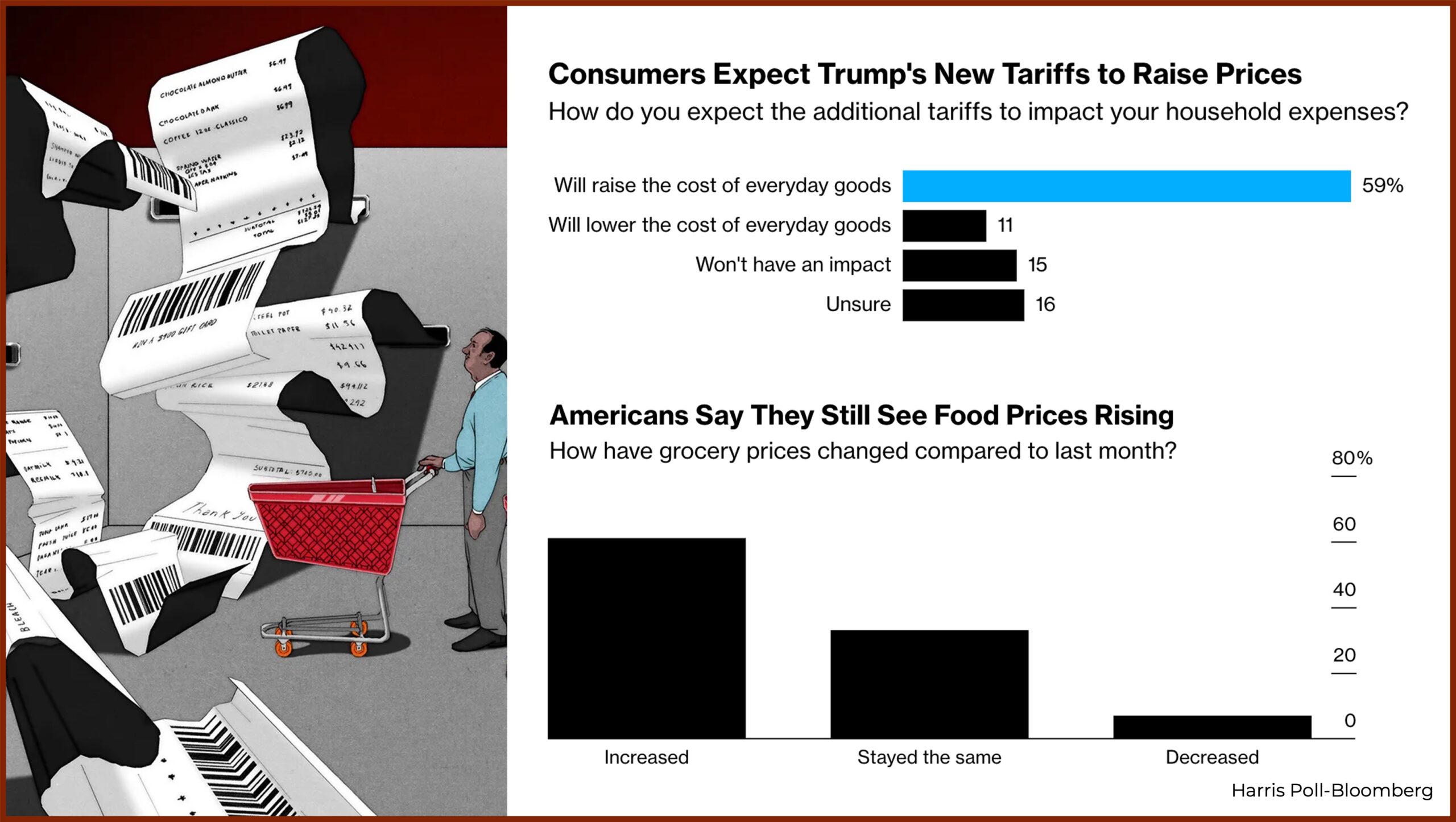
TARIFF WORRIES:
Most American consumers are worried about the impact of President Trump’s tariffs, according to our Harris Poll research with Bloomberg News.
- 59% expect Trump’s tariffs to lead to higher prices.
- 44% say tariffs are likely to be bad for the U.S. economy – compared to 31% who say they would be a boost.
- 61% say they already have noticed an increase in grocery prices in the last month.
- 59% believe tariffs will raise the cost of everyday goods further.
- Only 31% say the U.S. economy is working.
- Being able to comfortably afford monthly expenses (40%) is more important to Americans than a strong job market (26%), producing more of what we buy in the U.S. (13%), growth in innovation and new industries (11%) and a rising stock market and strong corporate performance (10%).
ECONOMIC PESSIMISM:
Most Americans believe the economy is getting worse rather than improving or staying the same, based to our Harris Poll research with The Guardian.
- 51% of Americans believe the U.S. economy is worsening.
- 20% say the economy is improving.
- More Republicans believe the U.S. economy is improving compared to the past (39% today versus 8% last May).
- More Democrats think it’s worsening today (69% today versus 36% last May).
- 47% of Americans believe the U.S. is currently in a recession (53% of Democrats, 46% of Independents and 43% of Republicans).
- Democrats (69%) and Independents (66%) believe the economy is worse than the media describe it.
- Republicans think the economy is better than media reports (56%).
U.S. EXODUS?:
Rising rent, healthcare and education costs are causing more Americans to consider moving overseas, according to our Harris Poll research with Fast Company.
- 42% of Americans have considered or plan to move abroad to improve their happiness.
- 19% of young people say they are seriously considering an imminent move.
- 52% believe they would have a higher quality of life living abroad.
- Lower cost of living (49%) is the top reason for considering a move, followed by dissatisfaction with the current political leadership (48%).
- The top five countries Americans would consider moving to are Canada, the UK, Australia, France and Italy.
ICYMI: In case you missed it, check out the thought-leadership and happenings around Stagwell making news:
![Risk and Reputation Unit Webinar March 7 2025 v2[8]](https://www.stagwellglobal.com/wp-content/uploads/2025/02/Risk-and-Reputation-Unit-Webinar-March-7-2025-v28-scaled.jpg)
Related
Articles
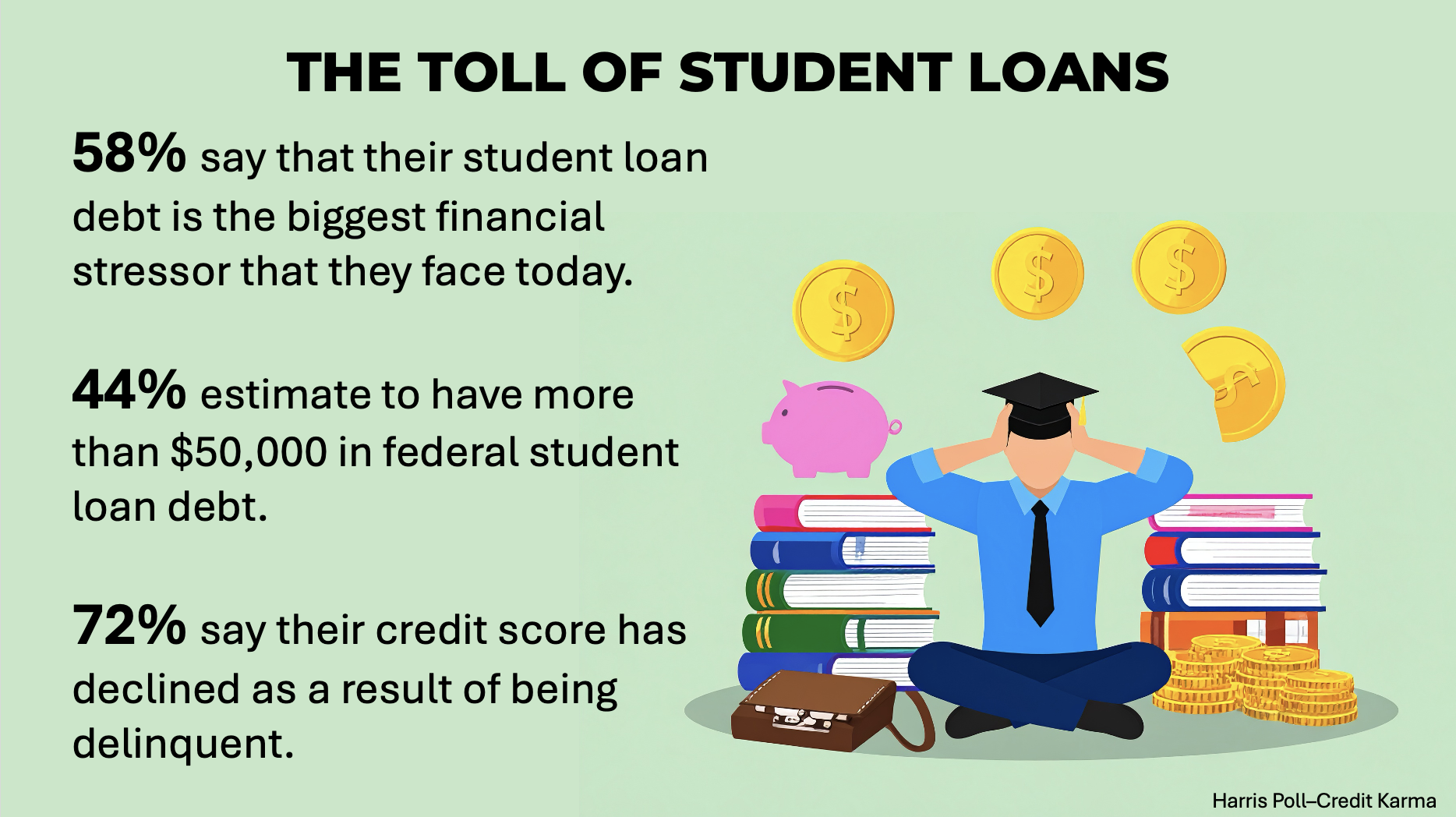
Weekly Data
Jun 19, 2025
WHAT THE DATA SAY: Two thirds of women see U.S. economy and inflation becoming worse
Women are feeling the financial strain of today’s economy more…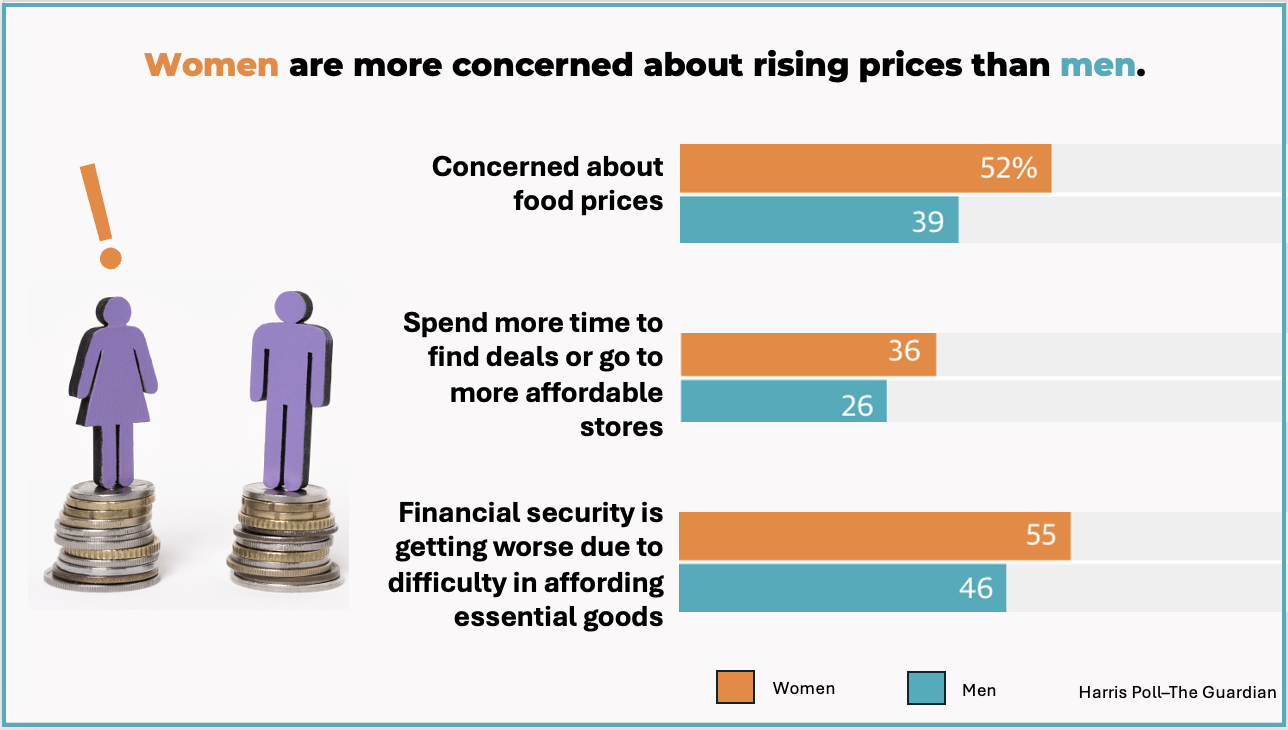
In the News, Press Releases
Jun 13, 2025
Stagwell (STGW) Unveils Official News Network as an Extension of its Future of News Initiative, Allowing Clients Direct Access to Leading News Publishers

Newsletter
Sign Up
New strategic leadership role will strengthen NRG’s position as a go-to partner for brands, platforms, and entertainment companies navigating brand challenges and shifting consumer dynamics
LOS ANGELES, March 4, 2025 /PRNewswire/ — NRG (National Research Group), a leading global insights and strategy firm at the intersection of entertainment, media, and technology, has appointed Fotoulla Damaskos to a first-of-its-kind Chief Client Strategist role, focused on accelerating the creativity, consultation, and strategic thinking NRG provides its clients.

“As the media and advertising landscape grows more fragmented, brands need more than just data—they need a true strategic partner to help them connect with audiences in meaningful ways,” said Fotoulla Damaskos, Chief Client Strategist at NRG. “This role is designed to make NRG an even more powerful force for clients, ensuring our insights don’t just inform, but actively drive business decisions, shape go-to-market strategies, and unlock new opportunities for growth.”
Damaskos’ appointment follows a strong track record helping NRG-clients Snapchat, Expedia, Amazon Prime Video, and many others unlock new opportunities through strategic insights. Most recently, she was part of an inter-agency team that helped Stagwell secure the global lead for creative campaigns and social content at Adobe. In this new role, Damaskos will be working across the firm to win and consult on high-value assignments by translating thought leadership, proprietary products, and unique methodologies into actionable strategies.
As Chief Client Strategist, Damaskos will work directly with brands, platforms, and media companies to convert consumer insights into competitive advantage. Whether by shaping brand positioning, mapping the impact of the creator economy to brand growth, or bringing proprietary tools like fan-centric brand measurement and creator insights into the hands of marketers, this role will serve as the bridge that connects data and insights to meaningful action and change.
“At NRG, we don’t just tell our clients what’s coming next; we help them define it,” said Grady Miller, CMO and Head of Trends & Futures at NRG. “This role strengthens our ability to turn insights into action, ensuring clients stay ahead of industry shifts. This appointment marks NRG’s evolution as a strategic growth partner—one that doesn’t simply measure success but helps create it.”
About NRG (National Research Group)
NRG is a leading global insights and strategy firm at the intersection of entertainment and technology. Rooted in four decades of industry expertise, the world’s most innovative brands turn to us for insights into growth and strategy for any content, anywhere, on any device. Working at the confluence of content, technology, and culture, NRG ensures our clients create with confidence.
About Stagwell
Stagwell is the challenger holding company built to transform marketing. We deliver scaled creative performance for the world’s most ambitious brands, connecting culture-moving creativity with leading-edge technology to harmonize the art and science of marketing. Led by entrepreneurs, our specialists in 40+ countries are unified under a single purpose: to drive effectiveness and improve business results for our clients. Join us at www.stagwellglobal.com.
Media Contact:
Don Halcombe
+1-312-730-0164
On behalf of NRG
doncommpr@gmail.com
Related
Articles
In the News, Press Releases, Thought Leadership
Jun 10, 2025
Stagwell (STGW) Chairman and CEO Mark Penn to Discuss the Irreplaceable Power of Human Creativity on the Main Stage of Cannes Lions

Events, In the News, Press Releases, Talent & Awards
Jun 05, 2025
Code and Theory Named ANA B2B Agency of the Year After Transforming the World’s Leading Brands

In the News, Press Releases, Talent & Awards
May 19, 2025
Stagwell (STGW) Appoints Connie Chan as Chief Growth Officer for Asia Pacific

Newsletter
Sign Up
NEW YORK, Feb. 13, 2024 /PRNewswire/ — Harris Quest, an AI-powered real-time research software suite from the Stagwell Marketing Cloud (NASDAQ: STGW), released new survey insights following Super Bowl LVIII gauging what really makes the Big Game so entertaining for the general population in the United States. Using QuestDIY to create, target and deploy quality surveys at speed, Stagwell generated insights fewer than 24 hours after the game’s conclusion and fewer than four hours of fielding to capture viewers’ perceptions around the hot topics, trends and memes surrounding Super Bowl 58.
“There were so many memorable moments around the Super Bowl, and this is just one example of how quickly QuestDIY can work for organizations looking to capture quality consumer insights quickly and efficiently,” said Stagwell Marketing Cloud CEO Elspeth Rollert. “With the added benefits of a generative AI survey builder, real-time analysis and reporting, and transparent cost estimates up front, our advanced survey platform is built for the modern marketer.”
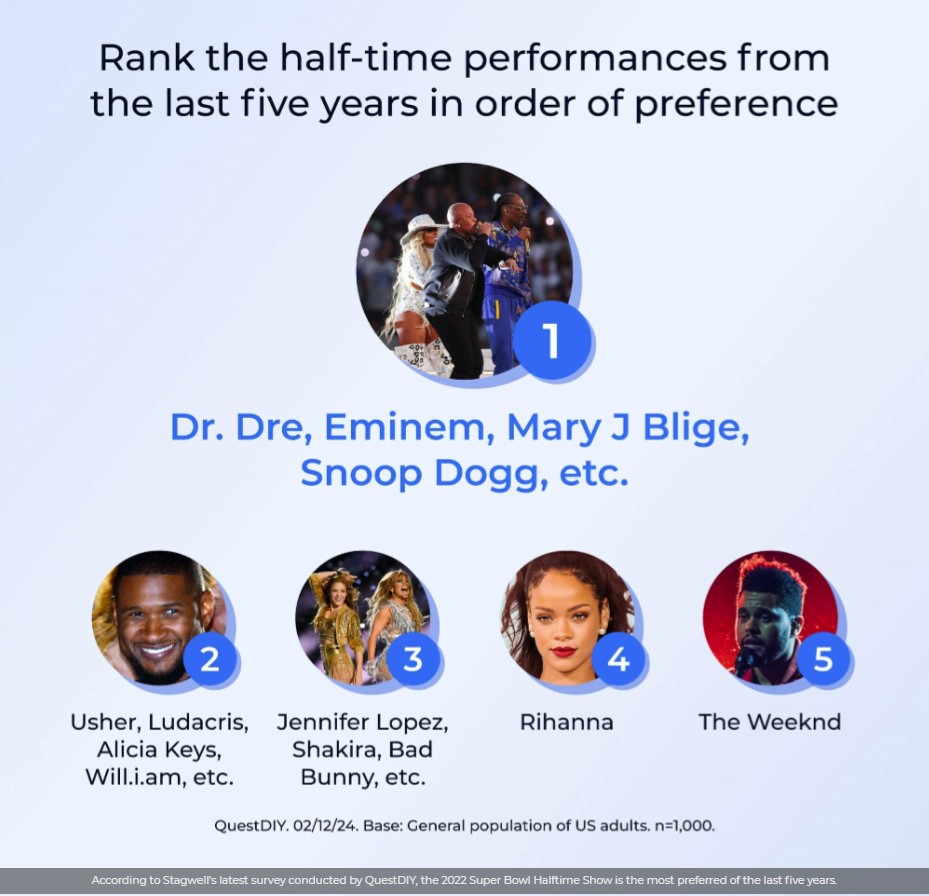
Big Game, Big Moments
- A country (Taylor) divided? With all eyes on America’s sweetheart, respondents were asked to recall how many times they saw Taylor Swift on screen during Super Bowl coverage, and the results were a near-split – with 47% indicating “The Right Amount,” and 45% noting “Too Much.”
- The meme of the night goes to: Travis Kelce yelling at Kansas City Chief Coach Andy Reid, with 1/4 of respondents claiming this as the most memorable meme of the night.
- Slam Dunkin’: “The DunKings,” the humorous spot from Dunkin’ featuring Ben Affleck, Matt Damon, and Tom Brady as a musical group performing for Jennifer Lopez in the studio, took the prize as the favorite ad of the Big Game.
- Ladies who ranch: Ranch emerged as the clear winner (35%) among condiments that pair best with the Super Bowl snack table – which increases to 42% for women when broken down by gender.
- Halftime heroes goes to: The hip-hop crew of 2022. While no one said “No” to Usher’s halftime performance this year with a little help from his friends Alicia Keys, H.E.R., Will.i.am., Lil Jon, Jermaine Dupri and Ludacris, his ranks second in order of preference from the last five years of shows, topped by Dr. Dre, Eminem, Mary J. Blige, Snoop Dogg, Kendrick Lamar, 50 Cent, and Anderson Paak in 2022. Jennifer Lopez, Shakira, Bad Bunny and J Balvin rank third, followed by Rihanna and The Weeknd, respectively.
QuestDIY enables creating, targeting, and deploying surveys at speed, enabling brands and other marketing organizations to capture feedback from consumers faster than ever, and to leverage generative AI to build surveys in line with industry best practices. Visit here to learn more: https://www.stagwellmarketingcloud.com/product-pages/harris-questdiy
Survey Methodology
Stagwell Marketing Cloud’s Super Bowl post-game survey was conducted online within the United States and completed on Monday, Feb. 12, 2024, among 1,000 respondents aged over 18 yrs. representative of the population based on age, gender, and region, by Harris Quest Research.
About Stagwell Marketing Cloud
Stagwell Marketing Cloud (SMC) is a marketing-focused, AI-enablement platform built for the modern marketer. Born out of Stagwell’s (NASDAQ: STGW) network of award-winning marketing agencies, SMC’s technology empowers marketers to drive business impact by giving them intuitive tools equipped with proprietary, actionable data. SMC’s portfolio of solutions powers strategic customer research, communications, and media activation for brands worldwide by leveraging technology such as generative and predictive artificial intelligence, shared augmented reality, and more. Get your head in the cloud at www.stagwellmarketingcloud.com.
Media Contact
Sarah Arvizo
pr@stagwellglobal.com
Related
Articles
In the News, Press Releases, Thought Leadership
Jun 10, 2025
Stagwell (STGW) Chairman and CEO Mark Penn to Discuss the Irreplaceable Power of Human Creativity on the Main Stage of Cannes Lions

Events, In the News, Press Releases, Talent & Awards
Jun 05, 2025
Code and Theory Named ANA B2B Agency of the Year After Transforming the World’s Leading Brands

In the News, Press Releases, Talent & Awards
May 19, 2025
Stagwell (STGW) Appoints Connie Chan as Chief Growth Officer for Asia Pacific

Newsletter
Sign Up
Contact:
hello@stagwellglobal.com
Yesterday, August 23, marked the first major national moment of the 2024 U.S. presidential election. Looking ahead, Stagwell’s Risk and Reputation Unit expects the next 18 months are going to be politically anti-business – compounded by a fraught calendar filled with potential flashpoints for brands. Ongoing reputational crises make it clear: you need to have your house in order, as your brand could be next on the attack list amongst a wide audience of engaged Americans.
THE MAJOR WEDGE ISSUES GOING INTO 2024
Americans Don’t Believe Economic Reporting
- 59% say current economic conditions are being misrepresented due to the upcoming election cycle
- 53% say the media and news sources discuss the economy inaccurately
- 60% say the economy isn’t as good as the new sources make it to be
(The Harris Poll, America This Week Wave 179)
Past Election Cycle Suggests Future Risk Ahead
- Disney’s trended average political split between Republicans and Democrats went from a nominal 2.6 points in 2019 to highly polarized 19.3 points in 2023 during its legal battle with Florida and Governor Ron DeSantis
- Nike’s political split went from 4.3 in 2019 to 16.3 in 2022 – the most divisive company that year – after the “Satan Shoes” controversy with their Lil Nas X partnership
- Twitter’s political split went from 13 points Democrat favor in 2022 to 11 points Republican favor in response to Musk’s takeover
(2023 Axios Harris Poll 100)
Politics Create Brand Dissonance
- 82% of all Americans say companies are becoming more political than ever
- 71% aren’t interested in supporting companies that have become too political, regardless if they agree with their stances
- 78% wish their preferred brands would stay out of politics
(The Harris Poll, July 2023)
HOW STAGWELL IS HELPING BUSINESS LEADERS SEE AROUND CORNERS
As featured this week in PRovoke, Stagwell’s Risk and Reputation Unit’s bipartisan team of political, financial, and public opinion specialists will prepare brands for the grueling ongoing political cycle and polarized society.
The Unit brings together experts from left-of-center strategic advisory SKDK, right-of-center digital-first agency Targeted Victory, financial communications firm Sloane & Company, insights and research firm The Harris Poll, and Stagwell’s corporate leadership.
This fall, we will host three in-person luncheon briefings for business leaders aimed at unpacking what the next 18 months hold and how brands should prepare themselves. Dates are as follows:
- NEW YORK: September 13, 2023
- WASHINGTON, D.C.: September 20, 2023
- CHICAGO: September 27, 2023
To request a seat at our events, receive a consultation about the risks your brand faces, or join the mailing list for future updates, please reach out to hello@stagwellglobal.com.
Related
Articles
In the News, Press Releases, Thought Leadership
Jun 10, 2025
Stagwell (STGW) Chairman and CEO Mark Penn to Discuss the Irreplaceable Power of Human Creativity on the Main Stage of Cannes Lions

Events, In the News, Press Releases, Talent & Awards
Jun 05, 2025
Code and Theory Named ANA B2B Agency of the Year After Transforming the World’s Leading Brands

In the News, Press Releases, Talent & Awards
May 19, 2025
Stagwell (STGW) Appoints Connie Chan as Chief Growth Officer for Asia Pacific

Newsletter
Sign Up
By: Ray Day
CONTACT:
We wanted to share our latest consumer and business insights, based on research from Stagwell. Among the highlights of our weekly consumer sentiment tracking (fielded July 21-23):
WEEKLY WORRIES ABOUT ECONOMY JUMP BACK UP:
Today, 87% of Americans are concerned about the economy and inflation – up 2 points from last week and higher than December’s 82% rate.
- 81% worry about a potential U.S. recession (up 5 points)
- 79% about affording living expenses (up 9 points)
- 74% about political divisiveness (no change)
- 84% about U.S. crime rates (up 1 point)
- 72% about the War on Ukraine (up 5 points)
- 58% about a new COVID-19 variant (up 7 points)
- 57% about losing their jobs (up 10 point)
INFLATION AND AI REMAIN TOP NATIONAL CONCERNS:
Inflation is still hitting Americans across the political spectrum, and fears about AI are real, according to our most recent poll with the Center for American Political Studies at Harvard University.
- 76% say inflation has affected them and their family’s finances, with groceries (49%) as the area inflation has hit the hardest.
- 60% think the inflation rate is continuing to increase even though that is not true.
- When it comes to AI, 74% of Americans – including more than 70% of each political party – think AI technology can be dangerous and that fears of it are not overblown.
- 51% of Democrats are optimistic about AI, while 59% of Republicans are fearful.
- 72% of Republicans compared with 52% of Democrats think AI advancements will mostly destroy rather than add jobs.
- 79% of all Americans want more regulations around AI.
- 62% want regulations to emerge from the tech industry rather than from lawmakers.
TOP BRANDS FLYING PAST AFFINITY TO CREATE SUPERFANS:
The renewed Barbie fascination as well as Taylor Swift and Marvel all have one thing in common: they each have learned how to unlock the power of brand fandom – versus just affinity – by unleashing “superfans.” And it’s paying huge dividends, according to the new “The Fandom Formula Report” from Stagwell’s National Research Group.
- Brand fans are 3.5 times more likely to advocate for you, 3 times more likely to stick with you even if they try something they don’t like, more willing to pay a price premium, and 2 in 3 brand fans will try a new product.
- 73% of Americans consider themselves a superfan of at least one brand.
- Top categories attracting superfans include: fast food restaurants (63%), musician/band (60%), entertainment franchise (52%) and online personalities or content creators (50%).
- 71% of superfans became so gradually over time.
- 29% say it was a singular moment that turned them into a superfan.
PREPARING FOR BACK TO SCHOOL STRESS:
Heading back to school is more stressful than ever, according to our Harris Poll survey with On Our Sleeves Movement for Children’s Mental Health.
- 71% of parents say their children experienced challenges last school year.
- The top factors identified by parents included safety concerns (37%), academic challenges (26%), bullying (24%), ongoing social challenges related to the pandemic (24%) and mental health challenges (22%).
- 50% of parents also feel their child(ren)’s mental health has suffered during the past 12 months because of social media use.
EMPLOYEES NOT READY FOR ETHICAL DILEMMAS:
Workplace training is failing young workers, and business leaders need to do more to empower future leaders in sustaining ethical workplace cultures, according to our Harris Poll research with AICPA & CIMA.
- 90% of U.S. and UK employees say they are familiar with their company’s code of ethics.
- 71% say they have received ethics training.
- Yet only 26% of future talent – those aged 20 to 30 pursuing an advanced degree, looking for work or working for less than ten years – found the training to be “very effective.”
- Only 24% of workers feel “very prepared” to an ethical dilemma at work.
ICYMI
In case you missed it, check out some of the thought-leadership and happenings around Stagwell making news:
- Rookie managers make nearly half of female employees want to quit
- Employers Prefer In-Person Interviews, but 40% Fold In Virtual Components
- 20 brands catching Gen Z’s attention right now
- Majority of Americans Mistakenly Believe Health App Data is Covered by HIPAA
As always, if helpful, we would be happy to provide more info on any of these data or insights. Please do not hesitate to reach out.
Thank you.
Related
Articles
In the News, Press Releases, Thought Leadership
Jun 10, 2025
Stagwell (STGW) Chairman and CEO Mark Penn to Discuss the Irreplaceable Power of Human Creativity on the Main Stage of Cannes Lions

Events, In the News, Press Releases, Talent & Awards
Jun 05, 2025
Code and Theory Named ANA B2B Agency of the Year After Transforming the World’s Leading Brands

In the News, Press Releases, Talent & Awards
May 19, 2025
Stagwell (STGW) Appoints Connie Chan as Chief Growth Officer for Asia Pacific


